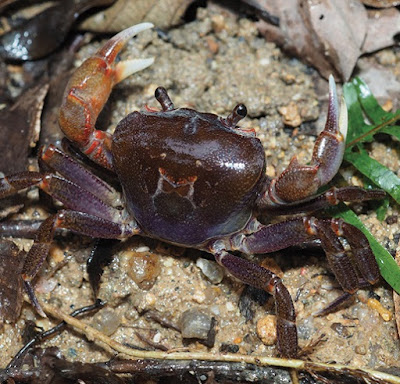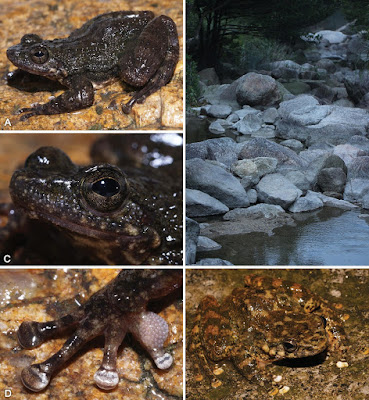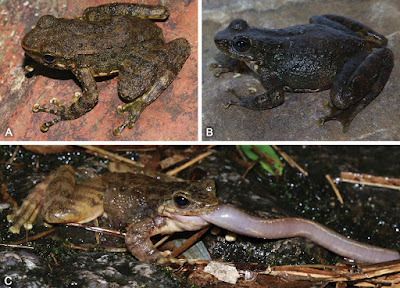[Most Recent Entries] [Calendar View]
Monday, January 7th, 2019
| Time | Event | ||||||
| 3:40a | [Crustacea • 2018] The Freshwater Crabs (Decapoda, Potamidae) of Macau, with the Description of Nanhaipotamon macau and the Redescription of Nanhaipotamon wupingense
Abstract Four species of freshwater crabs from three genera and two families (Cantopotamon hengqinense Huang, Ahyong & Shih, 2017, Nanhaipotamon guangdongense Dai, 1997, Nanhaipotamon macau sp. n., and Somanniathelphusa zanklon Ng & Dudgeon, 1992) are documented from Macau for the first time. One new species, Nanhaipotamon macau sp. n., is described. The large flap on the male first gonopod terminal segment sets it apart from all other known congeners except N. wupingense Cheng, Yang, Zhong & Li, 2003, from Fujian. Characters of the carapace, male first gonopod and size, however, clearly differentiate these two species. Preliminary genetic studies also suggest that the two are not closely related. A neotype is designated for N. wupingense. The taxonomic status of Nanhaipotamon guangdongense is also discussed. Notes on the general biology and conservation status of these crabs are also included. Keywords: Freshwater crabs, Gecarcinucidae, Macau, new species, Potamidae, systematics Taxonomy • Family Potamidae Ortmann, 1896 Subfamily Potamiscinae Bott, 1970 Genus Cantopotamon Huang, Ahyong & Shih, 2017 •• Cantopotamon hengqinense Huang, Ahyong & Shih, 2017 Distribution: Hengqin Island, Zhuhai, Guangdong; Coloane, Macau.
Genus Nanhaipotamon Bott, 1968 •• Nanhaipotamon macau sp. n. Diagnosis: Carapace broader than long, regions indistinct, dorsal surface convex, anterolateral region weakly rugose (Figs 3A, 4B); postorbital cristae sharp, laterally expanded, almost fused with epibranchial teeth and epigastric cristae (Figs 3A, 4B); external orbital angle sharply triangular, outer margin gently convex to almost straight, separated from anterolateral margin by conspicuous gap (Figs 3A, B, 4B); sub-orbital regions covered by sparse low granules, pterygostomial regions covered with short rows of a few rounded granules; sub-hepatic regions covered with lined striae (Fig. 3B); maxilliped III exopod reaching to proximal one-third of merus with short flagellum (Fig. 5A); female vulva ovate, medium-sized, positioned closely to one another (Fig. 4D); male pleon triangular, lateral margins almost straight (Fig. 3C); G1 slender, subterminal segment tapering distally, terminal segment large, distally expanded, distal margin laminar, apex blunt, directed outward (Figs 5C–E, 6A–C). G2 basal segment subovate (Fig. 5B). Etymology: This species is named after the type locality, Macau; used as a noun in apposition. Habitat: Nanhaipotamon macau sp. n. is a typical semi-terrestrial species that burrows in wet soil in the bank adjacent to hill streams. It was sympatric with Cantopotamon hengqinense at three localities. Distribution: Coloane, Macau. •• Nanhaipotamon guangdongense Dai, 1997 •• Nanhaipotamon wupingense Cheng, Yang, Zhong & Li, 2003 • Family Gecarcinucidae Rathbun, 1904 Genus Somanniathelphusa Bott, 1968 •• Somanniathelphusa zanklon Ng & Dudgeon, 1992 Chao Huang, Kai Chin Wong and Shane T. Ahyong. 2018. The Freshwater Crabs of Macau, with the Description of A New Species of Nanhaipotamon Bott, 1968 and the Redescription of Nanhaipotamon wupingense Cheng, Yang, Zhong & Li, 2003 (Crustacea, Decapoda, Potamidae). ZooKeys. 810: 91-111. DOI: 10.3897/zookeys.810.30726 Chao Huang, Shane T. Ahyong and Hsi-Te Shih. 2017. Cantopotamon, A New Genus of Freshwater Crabs from Guangdong, China, with Descriptions of Four New Species (Crustacea: Decapoda: Brachyura: Potamidae). Zoological Studies. 56; 41. DOI: 10.6620/ZS.2017.56-41 | ||||||
| 8:00a | [Botany • 2019] Eugenia megamalayana (Myrtaceae) • A New Species from the Western Ghats, India
Abstract Eugenia megamalayana sp. nov., is described and illustrated as a new species from the Western Ghats, Tamil Nadu, India. It is very closely allied to Eugenia calcadensis Bedd. but differs in habit, leaf, floral and fruit characters. The comparison of the two species is tabulated here. Keyword: Eugenia, India, Myrtaceae, New species, Western Ghats
Eugenia megamalayana Murugan & Arum., sp. nov. Ecology: This new species is hitherto known only from the type locality. Here it grows as big trees between 1100 m and 1500 m asl. The main associated species are, Acrocarpus fraxinifolius Arn., Artocarpus heterophyllus Lam., Bischofia javanica Blume, Chukrasia tabularis A. Juss. and Coffea sp. the coffee plantation. Etymology: The specific epithet is derived from the type locality Megamalai Wildlife Sanctuary, a potential area for plant diversity.
Chidambaram Murugan and Senniappan Arumugam. 2019. Eugenia megamalayana sp. nov. (Myrtaceae), A New Species from the Western Ghats, India. Taiwania. 64(1); 23-27. DOI: 10.6165/tai.2019.64.23 | ||||||
| 10:22a | [Herpetology • 2019] Amolops sinensis & A. yatseni • Two Cryptic Species of the Amolops ricketti group (Anura, Ranidae) from southeastern China
Abstract Two cryptic species, which were previously reported as Amolops ricketti, are revealed on the basis of significant morphological and genetic divergences. Amolops sinensis sp. n. from central Guangdong, northeastern Guangxi and southwestern Hunan can be distinguished by the longitudinal glandular folds on the skin of the shoulders and other character combinations. Amolops yatseni sp. n. from the coastal hills of west Guangdong can be distinguished by the dense tiny round translucent, or white, spines on the dorsal skin of the body, dorsal and dorsolateral skin of the limbs, and other character combinations. The phylogenetic interrelationships of the A. ricketti group have been inferred as (A. wuyiensis + A. ricketti) + (A. yunkaiensis + (A. albispinus + (A. sinensis sp. n. + A. yatseni sp. n.))). This work indicates that the current records of A. ricketti might be a species complex composed of multiple species, and further work is needed to figure out this puzzle. Keywords: Amolops sinensis sp. n., Amolops yatseni sp. n., mitochondrial DNA, morphology, phylogeny, species complex, torrent frog
Amolops sinensis Lyu, Wang & Wang, sp. n. Diagnosis: The new species was assigned to genus Amolops and further to the A. ricketti group morphologically based on the absence of dorsolateral folds, the presence of a circummarginal groove on the disk of the first finger, the absence of tarsal glands, and the presence of nuptial pads with conical nuptial spines on the first finger in males. Amolops sinensis sp. n. is distinguished from its congeners by a combination of the following morphological characteristics: (1) body stout and robust, SVL 40.2–46.5 (43.1±2.2, n=6) mm in adult males, 47.7–52.7 (50.5±2.0, n=5) mm in adult females; (2) dorsal body olive-brown to dark brown, with irregular light strip-shaped patches or not; (3) ventral surface creamy white or beige, with dark gray patches; (4) dorsal skin of body very rough, granular and scattered with conical tubercles and raised large warts in males; (5) vomerine teeth strong, tongue cordiform, deeply notched posteriorly; (6) absence of dorsolateral folds; (7) a longitudinal glandular fold on skin of shoulder on each side; (8) supernumerary tubercles below base of fingers III and IV indistinct; (9) heels overlapping; (10) absence of outer metatarsal tubercles and tarsal glands; (11) absence of vocal sacs; (12) nuptial pad on first finger prominent with beige spines in breeding males; and (13) white conical spines present on skin of temporal region (including tympanum in several individuals) and loreal region in breeding males. Etymology: The specific name “sinensis” refers to “Chinese”, for this new species takes a wide distribution in southern China. We suggest its English common name “Chinese Torrent Frog” and Chinese name “Zhong Hua Tuan Wa (中华湍蛙)”. Distribution and habits: Currently, the Chinese Torrent Frog is recognized from the Shimentai Nature Reserve and Mt. Nankun in Guangdong, Mt. Dupangling in Guangxi, and Mt. Yangming and Mt. Hengshan in Hunan, which indicates the potential distribution area of Amolops sinensis sp. n. is from central Guangdong, to northeastern Guangxi and southwestern Hunan. Amolops sinensis sp. n. inhabits rocky, fast-flowing streams (ca 500–1300 m a.s.l.) surrounded by moist subtropical secondary evergreen broadleaved forests. All individuals were observed from April to August. Males bear nuptial spines from April to July; females bear mature light yellow oocytes from April to August. Nevertheless, much of the ecology and behavior of this species remains unknown. Amolops yatseni Lyu, Wang & Wang, sp. n. Diagnosis: The new species was assigned to genus Amolops and further to the A. ricketti group morphologically based on the absence of dorsolateral folds, the presence of a circummarginal groove on the disk of the first finger, the absence of tarsal glands, and the presence of nuptial pads with conical nuptial spines on the first finger in males. Amolops yatseni sp. n. is distinguished from its congeners by a combination of the following morphological characteristics: (1) body stout and robust, SVL 39.3–44.7 (42.5±2.1, n=6) mm in adult males, 42.1–48.9 (46.4±2.0, n=11) mm in adult females; (2) dorsal body olive-brown or light brown, with irregular light strip-shaped patches or not; (3) ventral surface creamy white, with nebulous dark gray patches or not; (4) dorsal skin of body very rough, granular and scattered with tubercles and raised large warts, lacking warts on central back of trunk in females; (5) dense tiny round translucent, or white, spines present on dorsal skin of body, dorsal and dorsolateral skin of limbs in males, denser in females; (6) vomerine teeth strong, tongue cordiform, deeply notched posteriorly; (7) absence of the dorsolateral folds; (8) supernumerary tubercles below the base of fingers II, III and IV distinct and prominent; (9) heels just meeting; (10) absence of outer metatarsal tubercles and tarsal glands; (11) absence of vocal sacs; (12) nuptial pad on the first finger prominent with developed white conical spines in breeding males, tip of nuptial spines brown; and (13) dense white conical spines present on the skin of the temporal region (including the tympanum in several individuals), loreal region, snout, lips and chin in males during breeding season, and such spines less developed and rounded only on skin of temporal region except the tympanum and lower lips in females. Etymology: The specific name “yatseni” refers to the founder of Sun Yat-sen University, Dr. Sun Yat-sen, who was born in Cuiheng Village, Zhongshan City, about five kilometers from the type locality, Mt. Wugui. We suggest its English common name “Yat-sen’s Torrent Frog” and Chinese name “Yi Xian Tuan Wa (逸仙湍蛙)”. Distribution and habits: Currently, the Yat-sen’s Torrent Frog is known from the Zhongshan City, as well as from Mt. Gudou, Shangchuan Island, Ehuangzhang Nature Reserve, and Yunkaishan Nature Reserve. All these localities are situated in the coastal hills of west Guangdong, indicating the potential distribution area of Amolops yatseni sp. n. is from the west border of Pearl River Delta to the Yunkai Mountains. However, the five known localities of the new species are being threatened by hydropower station construction and tourism development respectively, and surveys are needed in western Guangdong to investigate the accurate population status and the distribution of this species. Amolops yatseni sp. n. inhabits rocky, fast-flowing streams (ca 250–1000 m a.s.l.) surrounded by moist subtropical secondary evergreen broadleaved forests (Fig. 7C). All individuals were observed from March to August when males bear nuptial spines and females bear mature oocytes. Nevertheless, much of the ecology and behavior of this species remains unknown. Discussion: The species Amolops ricketti was originally described based on two specimens from Mt. Wuyi, Fujian (Boulenger 1899), and was recorded subsequently over wide area from southern China to northern and central Indochina (Bourret 1942; Liu 1950; Fei et al. 2012; Frost 2018). In this work, we have found that the recorded population of A. ricketti from central Guangdong, northeastern Guangxi and southwestern Hunan (now recognized as A. sinensis sp. n.) and from coastal hills of west Guangdong (now recognized as A. yatseni sp. n.), are markedly different from the topotype of A. ricketti from Fujian, both morphologically and genetically. This indicates that the current records of A. ricketti might be a species complex (designated here as A. ricketti sensu lato) composed of multiple species. Further surveys and studies are required to clarify the concept of A. ricketti, especially for the reported populations from southwestern China and Indochina and to determine the accurate distribution of A. sinensis sp. n. and A. yatseni sp. n. Southwestern China has been considered as hotspot area with highest species diversity over time, while southeastern China, which suffers from more human activities, is considered as much less diverse, which may reflect the lack of biodiversity surveys over time. Recently, a number of new amphibian species were described from southeastern China (Lyu et al. 2017; Wang et al. 2017; Yuan et al. 2017; Zeng et al. 2017; Lyu et al. 2018; Wang et al. 2018a; Wang et al. 2018b; this study), to be the greatest number of new amphibian species in China in recent times. These discoveries indicate that the species diversity in southeastern China is highly underestimated. Comprehensive and careful surveys are urgently demanded to investigate the biodiversity status in this area, especially for herpetological species which are sensitive to rapid environmental changes. Zhi-Tong Lyu, Lin-Sheng Huang, Jian Wang, Yuan-Qiu Li, Hong-Hui Chen, Shuo Qi and Ying-Yong Wang. 2019. Description of Two Cryptic Species of the Amolops ricketti group (Anura, Ranidae) from southeastern China. ZooKeys. 812: 133-156. DOI: 10.3897/zookeys.812.29956 |
| << Previous Day |
2019/01/07 [Calendar] |
Next Day >> |














